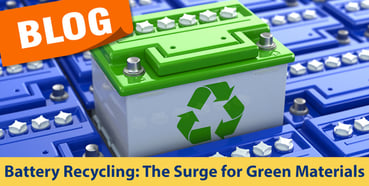
We are in a battery recycling boom! A strong push from consumers for corporate responsibility in source origins and greener options overall has been felt by companies all over the world. Using recycled materials can be a cost-effective, logical choice for supporting Green Initiatives and boosting the bottom line.Companies have taken note and are switching to recycled materials, including batteries. Large companies like Apple are leading the way down a greener path by sourcing recycled materials for their products, in some cases exclusively so. Apple recently announced its commitment to using the following 100 percent recycled materials by 2025:
- Cobalt for its batteries
- Rare earth elements for its magnets
- Tin solder for its printed circuit boards
- Gold plating for its printed circuit boards1
So, let’s discuss what kinds of batteries can be recycled, why some older batteries contain mercury, and why it is important to evaluate mercury levels in the battery recycling processes.
What kinds of batteries can be recycled?
Virtually all batteries can be recycled. Some, like lead acid car batteries, are 99 percent recyclable.2 The components can all be separated, and each material goes into a different recycling stream. The metals are often used to make new batteries, while the plastics and other chemical components are sold to other manufacturing industries.
What kinds of batteries contain mercury and why was it added?
Mercury is known to be toxic to plants, animals, and the environment. A variety of older button-cell batteries contain mercury. Button-cell batteries are small, thin, and not rechargeable. They are used mostly in watches, toys, and hearing aids.
Gas can form in button-cell batteries due to the corrosion of zinc. This corrosion can cause electrolysis and generate hydrogen gas. Build-up of hydrogen gas can cause the battery to leak and quit working. Mercury suppresses zinc corrosion, which is why it was added to button-cell batteries. Technological advancements have allowed for the phasing out of added mercury without losing energy capacity or increasing prices.3
Is mercury still used in batteries?
Production of batteries containing mercury was outlawed for public use in the United States by the Battery Act of 1996. There are still some authorized military applications for batteries of this type.4 Mercury-containing button cell batteries have been prohibited in the European Union since October 2015. There are now mercury-free alternatives that come in the same shape and size as their predecessors.5
Why is it necessary to test battery recycling waste streams for mercury?
Since it is common for recycling facilities to accept bulk quantities of spent batteries from consumers, there could be mercury-containing button cell batteries mixed in with the other types. When the bulk batteries go through mechanical separation (i.e., shredding or hammermilling into smaller pieces), the components are released from inside the casings. The small pieces are then taken through several chemical and physical separation techniques. Any waste products generated from this (especially liquid waste effluent) need to be evaluated for mercury contamination.
Why is it important?
Recycling batteries is important because it keeps hazardous materials out of our landfills and re-uses them in a beneficial way. Recycling reduces the need to mine and process metals, like cobalt and lithium, which are essential for rechargeable batteries. The need for batteries is increasing rapidly. This is especially driven by the car industry’s shift towards electric vehicles and as industries shift toward greener products. There are a variety of benefits across multiple sectors from recycling batteries.
Those benefits include:
- Reduction in waste sent to landfills
- Conservation of natural resources, like lithium and cobalt metals
- Reuse to make new products
- Creation of new, well-paying jobs in the recycling and manufacturing industries
- Movement to greener options
- Development of clear plans for all waste streams, which can help businesses outpace the competition6
Do your part! Once batteries are used up, recycle them so they can be transformed into new items. Your next car battery or cell phone could be made of components from your previous ones! Check local guidelines about how to recycle batteries where you live.
For more information on Leeman Labs Mercury Analyzers or if you would like to someone to contact you - click the button below. References
References
2. https://analyticalscience.wiley.com/do/10.1002/gitlab.15680/
3.https://mercuryconvention.org/sites/default/files/documents/working_document/compilation_01_batteries.pdf
4. https://www.epa.gov/mercury/mercury-batteries#:~:text=The%20mercury%20in%20button%20cell,garbage%2C%20they%20should%20be%20recycled.
5.https://mercuryconvention.org/sites/default/files/documents/working_document/compilation_01_batteries.pdf
6. https://www.cirbasolutions.com/learning-center/recycling-benefits/
